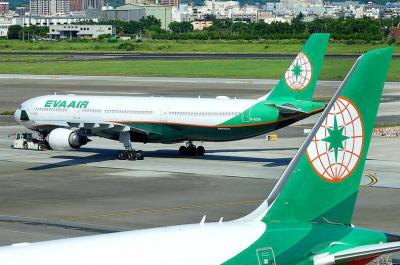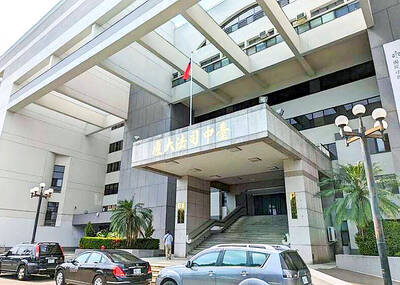Box office smash Barbie, the summer viral hit about the much-loved Mattel doll that many spent their childhoods playing with, has received eight nominations for this year’s Academy Awards, which is to be held on March 10.
The famous plastic doll, with her slender figure and chic fashion sense, achieved global commercial success following her 1959 debut and remains one of the most popular toys to date.
However, the brand’s success story cannot fully be told without paying tribute to a group of factory workers in a small northwestern Taiwan town, who, in the 1970s produced 80 percent of the world’s Barbie dolls.

Photo: CNA
Hsu Chu-lien (許菊蓮), a petite and lively woman in her late 60s, was once part of the 8,000-strong workforce at Mattel’s manufacturing base — the Meining (美寧) factory — established in 1967 in what is now New Taipei City’s Taishan District (泰山).
“There were over 3,000 employees at the factory, but including home-based subcontractors, about 8,000 of us received regular paychecks,” Hsu said.
She joined Mattel’s doll manufacturing plant in 1972 when she was 17, shortly after graduating from junior high school in Miaoli County.
She worked in the sewing department for six years, spending her days piecing together tiny dresses and accessories for the iconic doll and living in the company’s dormitory.
During its 20 years of operations until its closure in 1987, the Meining factory — a joint venture between Mattel and a Taiwanese company led by plastics manufacturing magnate Chao Ting-tsung (趙廷箴) — churned out nearly 1 billion dolls.
Mattel chose Taiwan as its location for making the dolls because of government incentives and cheap labor, according to a China Times report published in November 1967, months after the factory began operations.
However, all of the toys produced in the factory’s early years were exported and it was not until 1982 that the first Barbie model — a doll with a pink polka-dot top and white chiffon pettiskirt — was available in Taiwanese market.
Barbie was popular among the predominantly female factory workforce, and Hsu was no exception.
“Back then, there were not many dolls in the [Taiwanese] market,” Hsu said. “Barbie is so beautiful, who wouldn’t like her? Every girl liked her.”
It never occurred to her that she would one day be able to buy one, Hsu said, adding that a Barbie doll was a luxury that a factory worker with a meager monthly salary of NT$1,000 could not afford.
Still, the doll was so coveted that some were willing to risk swiping parts of the doll, a piece at a time, out of the factory, despite tight security checks, said Pai Li- ping (白麗萍), who worked at the Mattel factory for two years.
“Honestly, everyone was trying to sneak out bits of Barbie,” Pai said. “She is so beautiful and glamorous.”
“I used to put small parts in my lunchbox to avoid being caught by security,” Pai said, adding that she kept the dolls until recently.
“From a very young age, I felt this company was different,” she said about Mattel.
Pai, now in her 50s, continues to cherish the memories of sneaking into the Mattel complex as a child, clutching just a stool, as she tried to catch an outdoor movie screening, one of the many entertainment perks provided to employees and their families.
She joined the factory when she was 18, working in different departments for the next two years, from hair transplantation to sewing and eventually to molding, where she would meet her future husband.
Many of Pai’s colleagues, who joined the company in early adulthood, had similar experiences to her and marked some of the most important moments of their lives — like getting married or buying a house — while working at the company, the Taishin District Office said.
Pai and Hsu have no desire to put the years spent working at the factory behind them, despite the toy giant relocating its manufacturing base to China about four decades ago.
Pai, who works at a beauty salon, remains a member of the Meining Friendship Group, which organizes social gatherings for those who used to work at the plant.
Hsu, who is retired, has volunteered for 16 years at the Taishan Doll Museum, a small exhibition space in the New Taipei City town displaying dozens of the Barbie dolls and toys produced at the factory.
Established in 2004, the museum is dedicated to the time when Taishan, a small town where most people worked in farming, prospered by manufacturing Mattel dolls.
The museum, run by the district office, has sought to carve out its legacy for years in the town that is booming with various industries these days.
Holding workshops on producing doll clothes is part of that effort, said workshop lecturer Shami Kuo (郭雪美), who is an enthusiastic Barbie collector.
Students from all backgrounds have enrolled in the annual three-month-long workshop to learn how to produce garments for Barbie, Kuo said.
However, the focus is not on typical Barbie attire, but on exquisite pieces reflecting Taiwanese culture; for example, outfits worn by chiefs of Taiwanese Indigenous groups, she said.
The goal is to “celebrate Taiwan’s cultural heritage” as well as the beloved doll, Kuo said.

The first global hotel Keys Selection by the Michelin Guide includes four hotels in Taiwan, Michelin announced yesterday. All four received the “Michelin One Key,” indicating guests are to experience a “very special stay” at any of the locations as the establishments are “a true gem with personality. Service always goes the extra mile, and the hotel provides much more than others in its price range.” Of the four hotels, three are located in Taipei and one in Taichung. In Taipei, the One Key accolades were awarded to the Capella Taipei, Kimpton Da An Taipei and Mandarin Oriental Taipei. Capella Taipei was described by

EVA Airways today confirmed the death of a flight attendant on Saturday upon their return to Taiwan and said an internal investigation has been launched, as criticism mounted over a social media post accusing the airline of failing to offer sufficient employee protections. According to the post, the flight attendant complained of feeling sick on board a flight, but was unable to take sick leave or access medical care. The crew member allegedly did not receive assistance from the chief purser, who failed to heed their requests for medical attention or call an ambulance once the flight landed, the post said. As sick

The Taichung District Court yesterday confirmed its final ruling that the marriage between teenage heir Lai (賴) and a man surnamed Hsia (夏) was legally invalid, preventing Hsia from inheriting Lai’s NT$500 million (US$16.37 million) estate. The court confirmed that Hsia chose not to appeal the civil judgement after the court handed down its ruling in June, making the decision final. In the June ruling, the court said that Lai, 18, and Hsia, 26, showed “no mutual admiration before the marriage” and that their interactions were “distant and unfamiliar.” The judge concluded that the couple lacked the “true intention of

A drunk woman was sexually assaulted inside a crowded concourse of Taipei Railway Station on Thursday last week before a foreign tourist notified police, leading to calls for better education on bystander intervention and review of security infrastructure. The man, surnamed Chiu (邱), was taken into custody on charges of sexual assault, taking advantage of the woman’s condition and public indecency. Police discovered that Chiu was a fugitive with prior convictions for vehicle theft. He has been taken into custody and is to complete his unserved six-month sentence, police said. On Thursday last week, Chiu was seen wearing a white